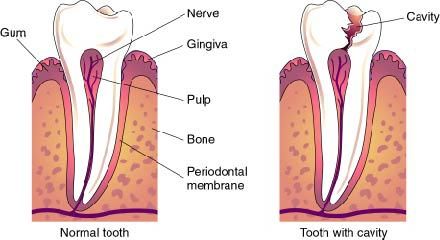Tooth decay, also known as a cavity, occurs when bacteria in plaque and foods break down the tooth structure. Foods and drinks that have sugars and carbohydrates in them cause changes in the mouth’s acid levels. Acids deteriorate the enamel, causing holes in the teeth.
Cavities usually start in the enamel, the outer layer of the tooth. They often occur in the pits and grooves of the biting surface of the tooth, or the contact area where two teeth come together. As they progress, they get into the dentin and eventually the nerve of the tooth. Cavities can also occur around the edges of older fillings, where the tooth enamel and filling meet.
Most people don’t feel cavities until the decay becomes extensive. It is best to see a dentist regularly, so the dentist can detect the cavity while it is small. When cavities are small, they can often be treated with a filling. If the cavity is untreated and gets bigger, it may need a crown and possibly a root canal. Dentists use both xrays and clinical exams to determine if patients have cavities.
There are some things that you can do to prevent cavities:
- Brush your teeth at least two times per day. We recommend brushing after meals to remove food and bacteria from the teeth.
- Floss daily to clean between the teeth. Cavities often start between the teeth for patients who don’t floss regularly.
- Use dental products that have fluoride in them. Fluoride remineralizes the enamel, and helps slow down tooth decay.
- Most importantly, see a dentist at least every 6 months for cleanings and exams!




